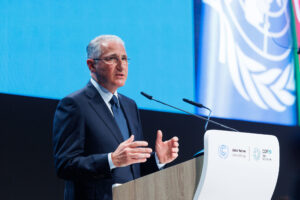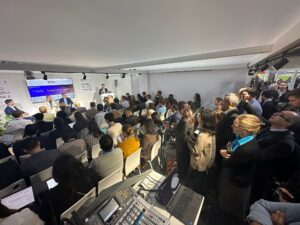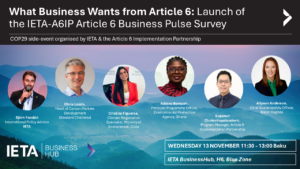COP29 update: Day 2, 12 November

Greetings from Baku!
You might be forgiven for expecting that after the opening CMA plenary produced such a major outcome for Article 6, that there would be a sense of anti-climax as the second day of COP29 began. But happily this was not the case.
For a start, there’s the annual hunt for COP’s Best Coffee to keep us interested. Now, I can’t claim to have subjected myself to the long lines at the Australian pavilion yet, but the Paul patisserie outlet in our hall stand serves a decent (and very large) cup, and they seem to be baking fresh croissants too!
Once appropriately caffeinated, there was plenty of reaction to yesterday’s decision to read through, much of it depressingly familiar in tone. “Legitimising carbon markets as a solution to climate change”; “carbon markets are not climate finance.”
And climate activists also attacked the process, saying that the COP’s early adoption was a “rogue move” that “sidesteps due process” by “ramming through loose standards for dangerous carbon crediting mechanisms behind closed doors”.
But as anyone who has followed the Article 6 process over the last few years knows, very little of what the Supervisory Body adopted was achieved behind closed doors. It’s been an open and transparent process with stakeholder involvement throughout. IETA staff have been regulars at their meetings.
It’s true that the SB’s decision to adopt the rules, rather than to submit proposed decisions to COP, was procedurally unusual; but perhaps the reason for that lies in the fact that the whole process has fallen well behind schedule (remember Dubai? Sharm el-Sheikh?), rather than in any desire to circumvent due process.
Meanwhile, IETA kicked off its side event programme with a standing-room-only session on the state of Article 6 negotiations, and Party delegates went into their contact groups to begin substantive talks on Article 6.2 issues.
This afternoon, Dirk Forrister and Björn Fondén joined a panel discussion at Singapore’s pavilion to offer further insights into the Article 6 talks and to highlight remaining issues that need to be addressed, including authorisation, registries and reporting.
Elsewhere, press conferences aren’t usually something we at IETA spend a lot of time attending, but it was very satisfying to watch this morning’s event featuring UNFCCC executive secretary Simon Stiell and the Azerbaijani lead negotiator Yalchin Rafiyev.
Both Messrs Stiell and Rafiyev highlighted that trading under Article 6 can unlock savings of as much as $250 billion a year in the cost of emissions abatement, a number that first came to light from IETA’s modelling work with the University of Maryland several years ago. They were also kind enough to namecheck IETA during the event.

The press conference also featured Maria AlJishi and Martin Hession, the chair and vice-chair of the Article 6.4 Supervisory Body, addressing yesterday’s CMA decisions.
AlJishi said the Article 6.4 standards on methodologies and removals have been drawn up to incentivise project developers to target “high-hanging fruit”, by focusing on ambitious projects that are not currently economically feasible.
Martin Hession called the 6.4 mechanism a “step-change” that provides access to a potential supply of credits that is in line with the Paris goals. “If people want to invest, we will deliver transformational projects, rather than just low-cost,” he said.
AlJishi told the conference that the adoption of the SB report means that “we can begin the work of developing further standards and guidance, and elaborating our way forward to enable all the tools to come into play, as soon as next year.”
“Many CDM projects have already begun transitioning to the Article 6.4 mechanism, and these are required to transition to Article 6.4 by next year,” she pointed out. “That means hopefully we could see the first issuance of 6.4 credits very soon.”
Asked about the process by which the decisions were adopted, AlJishi pointed out that “we are a UN body governed by the system; we must follow due process at all times. CMA is free to give us any guidance it wishes to.”

In the negotiations
The main event in the plenary rooms was the high-level segment of the COP, with world leaders presenting their national statements and in one case, unveiling an updated Nationally Determined Contributions well ahead of the February 2025 deadline.
UN Secretary-General António Guterres began proceedings by telling the COP that even more effort is needed.
“We need to implement solidarity levies on sectors such as shipping, aviation, and fossil fuel extraction – to help fund climate action,” he said. And “we need a fair price on carbon.”
Today was the turn of the United Kingdom to unveil its new NDC. Prime Minister Keir Starmer told the summit that the UK will cut emissions by 81% compared with 1990 levels by 2035.
Technically, this is not really new, since the UK government already increased its domestic emissions target following advice from its Climate Change Committee; but as a UNFCCC NDC it represents an increased commitment from the previous 78% target.
The UK’s “NDC 3.0” joined a very short list of early commitments from major emitters, with last year’s COP hosts the UAE (47% by 2035) and next year’s hosts Brazil (67%) also having published their new NDCs. WRI experts said it sets a “a high bar, that other countries should follow”.
Talks on the New Collective Quantified Goal on climate finance were difficult, with Parties unsurprisingly very far apart in terms of the sums of money being demanded or on offer. A new draft decision text will be put together tomorrow.
Outside the negotiating rooms, multilateral development banks announced that they will be putting up $120 billion a year in public finance to low and middle income countries, and they’ll mobilise $65 billion in private finance as well. This means they’re effectively committing to mobilise 54 cents in private finance for every dollar in public money, compared to 38 cents per public dollar before.
After the fanfare surrounding the Article 6.4 decision yesterday, it was back to work for the market mechanism negotiators, who were meeting this evening in a 6.2 contact group. We’ll have a read-out from this session tomorrow.

Today at the IETA Business Hub
Our Day 2 started with a bang, with a jam-packed side event (see above) at the IETA Business Hub to unpick the details of the Article 6.4 decisions, and to discuss outstanding issues on 6.4 as well as 6.2.
Led by our International Policy Director Andrea Bonzanni, a panel including negotiators from Switzerland, Colombia and New Zealand and joined by representatives of IETA members Sylvera and Abatable addressed a crowd that spilled out of the back of the side event room and into the walkway.
The session was recorded and we’ll upload it for you to watch as soon as possible.
We also hosted the World Economic Forum, who presented a discussion on scaling demand for clean technologies, the proceedings of which will also be uploaded shortly for you to view.
While our side event agenda was fairly light today, the Business Hub was as usual a popular destination, and our team is looking forward to a busy rest of the week.
Wednesday at the IETA Business Hub
Many of the events hosted at the IETA Business Hub will be webcast – just click on the links to participate! All event times are listed in Azerbaijan time (AZT), which is three hours ahead of Central European and two hours behind Singapore time.
IETA’s BusinessHub is located at Pavilion H6 of Area E in the Blue Zone. We’re close to the pavilions of Georgia, the Moana Blue Pacific alliance and Namibia.
Wednesday’s schedule starts at 0900 AZT (0600 CET if you’re a European insomniac) with a World Economic Forum session on Next Generation NDCs: Opportunities for Public Private Action. This event will be available on webcast here.
At 1000 AZT, the Wuppertal Institut and Germany’s Ministry for Economic Affairs & Climate Action will consider host countries’ readiness and outstanding needs for capacity building now that key Article 6.4 decisions have been taken. Watch this session here.
At 1130 AZT, IETA and the Article 6 Implementation Partnership will introduce their Article 6 Business Pulse survey. A live stream of the launch will be available here.

The Business Partnership for Market Implementation and ECOWAS are up next at 1300 AZT, presenting a session on the role of carbon markets and public-private partnerships in advancing sustainable development in the Global South. Virtual participants can join in here.
At 1530 AZT our friends from the University of Maryland and Landscape Indonesia will host a session on “Just Energy Transition: Carbon Market to Finance Early Retirement of Coal-Fired Power Plants with Renewables”. You can join the discussion here.
The final event of the day features the European Roundtable on Climate and Sustainable Transition (ERCST) who will present a discussion on the treatment of carbon removals. Virtual participants can follow this session here.